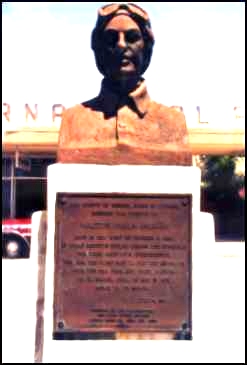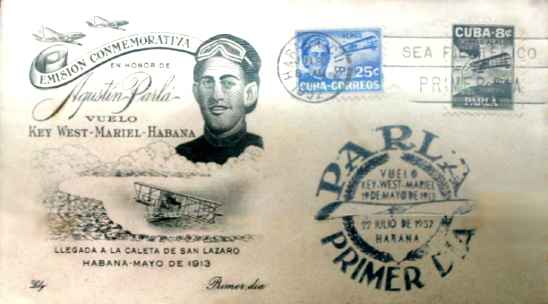| |
Agustin Parlá Orduña
Cuban Aviation Pioneer, and First Cuban Pilot
This page on Rubén Urribarres'
Cuban Aviation ,Aviación Cubana website offers some 14 biographies of important Cuban pioneer aviators, including Agustin
Parlá Orduña, in English. To go directly to his story, click on the title above.
If time permits, and you want to know more about Cuban Aviation, you will be amply rewarded by
going to the homepage and selecting several of the many sections such as: People, Articles etc.
Of special interest is a very nice article written by Rubén Urribarres entitled the
Audacious Flight of Rosillo and Parlá. This version is in Spanish,
but I will post a machine-translated article in English below for your convenience.
Audacious Flight
PARLA and ROSILLO MAKE the FLIGHT
Agustin Parlá has arrived at Key West with his hydroplane
and hopes to make the passage at the same time as Rosillo.
El Mundo Newspaper
11 of May of 1913
May 17, 1913, Domingo Rosillo and Agustin Parlá, pioneers of Cuban aviation, added their names
to the history of aviation, by making the first international flight of aviation in Latin America. They established a world-wide distance record
by flying their airplanes the 90 miles from Key West to Havana in 2 hours and 40 minutes. This record was snatched from nobody less
than the famous French pilot and aeronautical designer, Luis Bleriot.
The aerial trip between Key West in the U.S.A. and Havana was considered to be extremely dangerous.
North American aviator McCurdy had tried it without success in 1913 and the two Cubans would
repeat his attempt in the hope of better luck.
The City Council of Havana decided to reward the feat: "Ten thousand pesos for whoever arrives
first and five thousand for the second."
The flight would depend on the support of three ships of the Cuban Navy: the "Patria", which
would be stationed at 45 miles from Havana, the "Hatuey" at 30 miles, and the "24 de Febrero" at 15 miles from the finish. A North
American ship: the Auxiliary Gunboat "Peoria" also would
cooperate to insure the security of the intrepid pilots.
When the first airplane took off from Havana, the battery of La Cabaña would fire two cannon
shots to announce the start of the passage.
Nevertheless, the day of departure had not yet arrived. Rosillo had gone to Key West before Parlá and
had it not been that the propeller of his Bleriot-XI monoplane had been broken during a test flight, one he made to please the Cuban
immigrants who longed for a triumph, the flight would already have been attempted. He had to wait until a replacement propeller could
arrive from Cuba. Parlá arrived in Key West in his Curtiss hydroplane, which was powered by an engine of 80 horsepower.
Parlá, in spite of his lack of experience, had the superiority of his apparatus to make a
flight over the water in his favor. If it had to land unexpectedly on the ocean, at least it would be able to float. Anyway, Rosillo's propeller
was delayed even longer and although Parlá was ready for the flight, the conditions at the time were not favorable. It was known that
Rosillo would bring a letter valise with him and an order to buy tobacco at the Gato factory. The tobacco industry would thus use aviation
for its commercial operations for the first time. Finally, the long awaited propeller for the Bleriot monoplane arrived. Everything was ready
for the 17th.
At the first light of dawn of that day, on the smallest of three signal masts of the Morro de La Habana,
a red flag appeared: the public knew that it was the great day.
At 5:10 a.m., Rosillo departed. His airplane was baptized with the name of Habana and on the rudder was written, "Cuba."
He flew for 2 hours, 30 minutes and 40 seconds. At that point, he ran out of gas. A strong crosswind
had made him consume more fuel than he had anticipated.
After the trip was completed, he declared:
- My impressions of today? You have heard me speak of the storm under the skull?
"I began to see that the gasoline level was dropping in the indicating tube, at a rate faster than had
been calculated. All around I could only see sea and sky. The machine performed perfectly; I saw the "Hatuey", and passed it. The
tank was almost empty, but finally I saw Cuba. I had arrived without a drop of gasoline in the tank. I couldn't even make it to where I had
planned to land, in the Polígono de Columbia. I had to land instead in el campo de tiro. The wind had made me use more fuel than I had
planned. I had filled the tank with 50 liters, and on a lucky hunch, I had added 10 ounces more... "
Parlá, on the other hand, had left at 5:57 and by 6:01 he had to return: "I began the flight, but the
apparatus did not respond properly. It would not let me compensate for the wind that blew. When I returned and inspected it, I found
that two tension wires of the elevator were broken."
Rosillo was, without a doubt, the winner.
On the 19th, at 2:00 in the afternoon and without previous notification of his intentions, Parlá again
went in search of his goal. He did not have support from the Navy. Unlike Rosillo, who preferred to fly escorted by ships, Parlá
flew on his own. The news came as a surprise in Havana and the public prepared to receive the resolute aviatior. More than two hours
had passed, still the Curtiss was not seen from el Morro. Had he perished? Was he floating somewhere of the Caribbean?
Had he been blown off course by the wind, to who knows what place, and now he would fly without directions? everyone asked.
Soon the answer arrived: "aviator Agustin Parlá landed on the water in the bay of Mariel, at the risk
of his life, at 4:30 today, May 19, 1913. Motor failure had prevented him from reaching Havana, but he is well and already has started off
by automobile for the capital ".
Of the flight from Key West a reporter wrote, "... filled with limitless patriotism and a tenacious
resolution, he embarked on the trial flight. As the town had followed it from start to finish, they finally learned that the aviator had moved
steadily along the ideal course, the one that led to Cuba ".
The City Council of Havana awarded the second prize to Parlá, although, in truth, it was Cuba who won,
as was affirmed: "its name is registered in the history of aviation and will be placed among the advanced countries due to their
persistence to advance aviation up to the maximum limit".
Revista Sendas. Year 2, number 10, 1998. |
|




